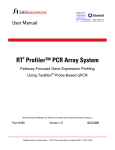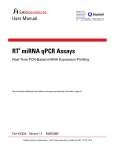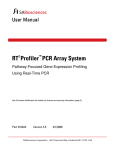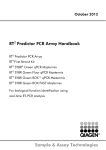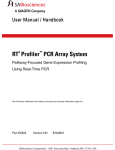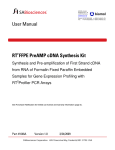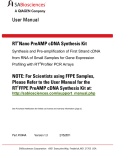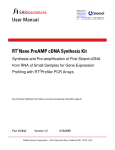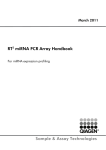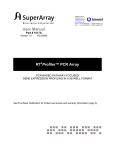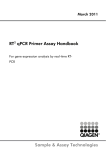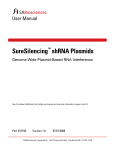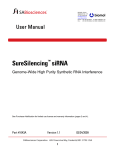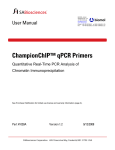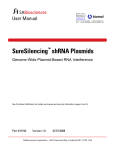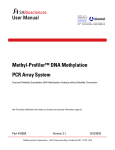Download User Manual - Biomol GmbH
Transcript
BIOMOL GmbH Waidmannstr. 35 22769 Hamburg [email protected] www.biomol.de Phone:+49-40-8532600 or 0800-2466651 (D) Fax: +49-40-85326022 or 0800-2466652 (D) User Manual 2 RT RNA QC PCR Arrays Quality Assurance and Control of Total RNA before Real-Time RT-PCR-Based Analysis See Purchaser Notification for limited use license and warranty information (page 3). Part# 1023A Version 1.5 6/6/2008 2 RT RNA QC PCR Arrays Quality Assurance and Control of Total RNA before Real-Time RT-PCR-Based Analysis User Manual (For Catalog Numbers: PAHS-999, PAMM-999, and PARN-999) Ordering and Technical Service Contact Information: • • • • Tel: Fax: On-line Order: E-MAIL: 1-888-503-3187 (US) 301-682-9200 (outside US) 1-888-465-9859 (US) 301-682-7300 (outside US) www.SABiosciences.com [email protected] (to place an order) [email protected] (for technical support) You may place orders by fax, e-mail or from our website. Each order should include the following information: • • • • • Your contact information (name, phone, email address) Product name, catalog number and quantity Purchase order number or credit card information (Visa or MasterCard) Shipping address Billing address For more information, visit us at www.SABiosciences.com SABiosciences Corporation 6951Executive Way Frederick, MD 21703 USA BIOMOL GmbH Waidmannstr. 35 22769 Hamburg [email protected] www.biomol.de Phone:+49-40-8532600 or 0800-2466651 (D) Fax: +49-40-85326022 or 0800-2466652 (D) CONTENTS I. Background and Introduction 4 II. Materials Provided 6 III. Additional Materials Required 7 IV. Complementary Products 7 V. Protocol 8 A. RNA Preparation and Quality Control 10 B. RT2 First Strand Kit 13 C. Performing Real-Time PCR 14 D. Data Analysis 18 VI. Troubleshooting and Frequently Asked Questions 20 LIMITED PRODUCT WARRANTY This product is intended for research purposes only and is not intended for drug or diagnostic purposes or for human use. This warranty limits our liability to replace this product in the event the product fails to perform due to any manufacturing defect. SABiosciences Corporation makes no other warranties of any kind, expressed or implied, including without limitation, warranties of merchantability or fitness for a particular purpose SABiosciences Corporation shall not be liable for any direct, indirect, consequential or incidental damages arising out of the use, the results of use or the inability to use this product. NOTICE TO PURCHASER The purchase of RT2 RNA QC PCR Array includes a limited, nonexclusive license to use the kit components for research use only. This license does not grant rights to use the kit components for reproduction of any primer pair mix, to modify kit components for resale or to use RT2 RNA QC PCR Array to manufacture commercial products without written approval of SABiosciences Corporation. No other license, expressed, implied or by estoppels, is granted. U.S. patents may cover certain isolated DNA sequences included in the RT2 RNA QC PCR Array. Presently, it is not clear under U.S. laws whether commercial users must obtain licenses from the owners of the rights to these U.S. patents 2 before using RT RNA QC PCR Array. 3 2 RT RNA QC PCR Arrays I. Background and Introduction The RT2 RNA QC PCR Array is designed to assess the quality of twelve (12) RNA samples simultaneously before characterization with the RT2Profiler™ PCR Array or the RT2 qPCR Primer Assays for real-time PCR based gene expression analysis. It contains a number of PCR controls, listed below, that test for RNA integrity, the presence of inhibitors of reverse transcription and PCR amplification and for genomic or general DNA contamination that confound SYBR Green based real-time PCR results. See Figure 1 for the layout of the RT2 RNA QC PCR Array. 1. Primer sets for two different housekeeping genes typically expressed at very different levels relative to one another provide a sense of the expected threshold cycle value ranges in subsequent reactions and a very rough sense of RNA integrity. 2. The RT2 First Strand Kit (C-03) synthesizes template from your RNA and from its built-in external RNA control, detectable by another primer set in the RNA QC PCR Array. This Reverse Transcription Control tests for the presence of inhibitors of the reverse transcription reaction in your RNA samples. 3. Positive PCR Controls contain a plasmid template with an artificial sequence and primers to detect it. Two controls are characterized with or without experimental template to test for the presence of PCR inhibitors in your RNA samples. 4. Two standard methods are used to sensitively detect genomic DNA contamination. The No Reverse Transcription control mixes primers for a housekeeping gene with total RNA instead of template to test for genomic DNA. Another primer set specifically amplifies nontranscribed Genomic DNA Contamination. 5. A control lacking experimental template serves as a No Template Control to test for the introduction of general DNA contamination during the experimental setup. Use the RT2 RNA QC PCR Array to test the quality of your RNA samples before wasting your master mix and PCR Arrays or primer sets on potentially sub-standard samples. Use the RT2 RNA QC PCR Array to Detect and Prevent: • • • • • Reverse transcription inhibition PCR amplification inhibition Genomic DNA contamination False positive signals Multi-peak dissociation curves Technical Support: [email protected] 4 www.SABiosciences.com A A B C cDNA template B D E C F G D H I RNA E J K F L M H2O G N O H P 24 23 12 22 21 11 20 19 10 18 17 9 16 15 8 14 13 7 12 11 6 10 9 5 8 7 4 6 3 5 3 2 2 384-well ↓→ 1 4 ↓ 96-well → 1 SAMPLE Version 1.5 1 2 HK1 3 4 1 2 HK1 3 4 1 2 HK1 3 4 1 2 HK1 3 4 1 2 HK1 3 4 1 2 HK1 3 4 1 2 HK1 3 4 1 2 HK1 3 4 1 2 HK1 3 4 1 2 HK1 3 4 1 2 HK1 3 4 1 2 HK1 3 4 1 2 HK2 3 4 1 2 HK2 3 4 1 2 HK2 3 4 1 2 HK2 3 4 1 2 HK2 3 4 1 2 HK2 3 4 1 2 HK2 3 4 1 2 HK2 3 4 1 2 HK2 3 4 1 2 HK2 3 4 1 2 HK2 3 4 1 2 HK2 3 4 1 2 RTC 3 4 1 2 RTC 3 4 1 2 RTC 3 4 1 2 RTC 3 4 1 2 RTC 3 4 1 2 RTC 3 4 1 2 RTC 3 4 1 2 RTC 3 4 1 2 RTC 3 4 1 2 RTC 3 4 1 2 RTC 3 4 1 2 RTC 3 4 1 2 PPC 3 4 1 2 PPC 3 4 1 2 PPC 3 4 1 2 PPC 3 4 1 2 PPC 3 4 1 2 PPC 3 4 1 2 PPC 3 4 1 2 PPC 3 4 1 2 PPC 3 4 1 2 PPC 3 4 1 2 PPC 3 4 1 2 PPC 3 4 1 2 GDC 3 4 1 2 GDC 3 4 1 2 GDC 3 4 1 2 GDC 3 4 1 2 GDC 3 4 1 2 GDC 3 4 1 2 GDC 3 4 1 2 GDC 3 4 1 2 GDC 3 4 1 2 GDC 3 4 1 2 GDC 3 4 1 2 GDC 3 4 1 2 NRT 3 4 1 2 NRT 3 4 1 2 NRT 3 4 1 2 NRT 3 4 1 2 NRT 3 4 1 2 NRT 3 4 1 2 NRT 3 4 1 2 NRT 3 4 1 2 NRT 3 4 1 2 NRT 3 4 1 2 NRT 3 4 1 2 NRT 3 4 1 2 PPC 3 4 1 2 PPC 3 4 1 2 PPC 3 4 1 2 PPC 3 4 1 2 PPC 3 4 1 2 PPC 3 4 1 2 PPC 3 4 1 2 PPC 3 4 1 2 PPC 3 4 1 2 PPC 3 4 1 2 PPC 3 4 1 2 PPC 3 4 1 2 NTC 3 4 1 2 NTC 3 4 1 2 NTC 3 4 1 2 NTC 3 4 1 2 NTC 3 4 1 2 NTC 3 4 1 2 NTC 3 4 1 2 NTC 3 4 1 2 NTC 3 4 1 2 NTC 3 4 1 2 NTC 3 4 1 2 NTC 3 4 2 Figure 1: Layout of the RT RNA QC PCR Arrays. Rows A & B: High (HK1, ACTB, Row A) and low (HK2, HPRT1, Row B) expression level housekeeping genes provide a sense of the expected threshold cycle value range in subsequent PCR Array analysis and an approximate sense of overall RNA integrity. Row C: The Reverse Transcription Control (RTC) tests the efficiency of the RT2 First Strand Kit (C-03) reaction with a primer set detecting the template from the kit’s built-in external RNA control. Rows D & G: The Positive PCR Controls (PPC) with (Row D) and without (Row G) experimental template test for inhibitors of the polymerase chain reaction using a predispensed artificial DNA sequence and the primer set that detects it. Row E: The Genomic DNA Control (GDC) primer set specifically detects non-transcribed genomic DNA contamination with a high level of sensitivity. Row F: The No Reverse Transcription control (NRT) tests for genomic DNA contamination in the RNA sample by trying to amplify a housekeeping gene directly from the RNA sample. Row H: The No Template Control (NTC), or so-called water control, tests for general DNA contamination in the PCR system introduced during plate setup. Rows A through E receive Experimental Cocktail #1 (master mix plus template). Row F receives Experimental Cocktail #3 (RNA diluted into master mix). Rows G and H receive Experimental Cocktail #2 (master mix only). The 384-well format of the PCR Arrays includes four replicates of the same 96-well format, in which each two-by-two set of wells (wells labeled 1 - 4 in gray above) contains the same primer set represented by the 96-well designations. Technical Support: 888.503.3187 (US) 5 301.682.9200 2 RT RNA QC PCR Array II. Materials Provided: The RT2 RNA QC PCR Arrays are available in six different plate formats, each tailored to a specific subset of real-time PCR instruments and associated blocks. Formats A, C, D, and F are 96-well plates, while Formats E and G are 384-well plates. Format: A C For Real-Time Instruments: Plate: All ABI “standard” blocks (7000, 7300, 7500, 7700, 7900) Bio-Rad iCycler, MyiQ, iQ5 Bio-Rad (MJ Research) Chromo 4 Eppendorf RealPlex Stratagene Mx3005p, Mx3000p ABI 7500 and 7900HT FAST 96-well blocks ABI StepOnePlus™ 96-well 96-well D Bio-Rad (MJ Research) Opticon and Opticon 2 Stratagene Mx4000 96-well E ABI 7900HT 384-well block 384-well F Roche LightCycler 480 96-well block 96-well G Roche LightCycler 480 384-well block 384-well NOTE: The format of the PCR Array is indicated by the last letter of the catalog number. Be sure that you have the correct PCR Array format for your instrument before starting the experiment. The Human, Mouse or Rat RT2 RNA QC PCR Array (PAHS-999, PAMM-999 or PARN999, respectively) is provided as a single plate per order. Each PCR Array includes either twelve (12) optical thin-wall 8-cap strips (Formats A and D) or one (1) optical adhesive film (Formats C, E, F, and G) per array. Storage Conditions: All components included in this kit are shipped at ambient temperature but must be stored at -20 °C upon receipt. When stored properly at -20 °C, their quality is guaranteed for 6 months. Technical Support: [email protected] 6 www.SABiosciences.com Version 1.5 III. Additional Materials Required: A. RNA Isolation Kit: See Page 10 for specific recommendations. B. RT2 First Strand Kit MANDATORY for a Complete and Successful Experiment For Reverse Transcription Control Detection (RTC, 96-well Row C or 384-well Rows E and F) (Cat. No. C-03) C. SABiosciences RT2 SYBR Green qPCR Master Mix MANDATORY for a Complete and Successful Experiment Be sure to pick the correct one for the instrumentation in your laboratory. RT2 SYBR Green / ROX qPCR Master Mix: Specifically designed for: All ABI and Stratagene Instrumentation Eppendorf Mastercycler® ep realplex Instruments with ROX filter set Catalog Number Size PA-012 For 2 RT2Profiler™ PCR Arrays RT2 SYBR Green / Fluorescein qPCR Master Mix: Specifically designed for BioRad iCylcer®, MyiQ®, and iQ5 Instrumentation Catalog Number Size PA-011 For 2 RT2Profiler™ PCR Arrays RT2 SYBR Green qPCR Master Mix: Specifically designed for instrumentation that does not require a reference dye: BioRad (MJ Research) Opticon, Opticon 2, and Chromo 4 Roche LightCycler® 480 System Eppendorf Mastercycler® ep realplex Instruments without ROX filter set Catalog Number Size PA-010 For 2 RT2Profiler™ PCR Arrays D. Equipment: 1. For recommendations on specific real-time instrumentation (thermal cyclers with fluorescent detection), see the list of master mixes and plate formats above. NOTE: The PCR Arrays are NOT recommended for the Cepheid SmartCycler®, the Roche LightCycler® 2.0, or the Corbett Research Rotorgene due to the different non-traditional hot block arrangements in those instruments. 2. Calibrated Micro-Pipettors 3. RNase / DNase-free pipette tips and tubes IV. Complementary Products: XpressRef™ Universal Total RNA: Universal RNA to control PCR conditions is available from the following species: Human XpressRef™ Universal Total RNA Mouse XpressRef™ Universal Total RNA Rat XpressRef™ Universal Total RNA Technical Support: 888.503.3187 (US) 7 (Cat. No. GA-004) (Cat. No. GA-005) (Cat. No. GA-006) 301.682.9200 2 RT RNA QC PCR Array V. Protocol: Please read through this entire protocol before beginning your experiment. RNA samples are very sensitive to RNase digestion; therefore, wear gloves and maintain an RNase-free work area while performing this protocol. NOTE: Master Mix and First Strand Kit Considerations The performance of the RT² RNA QC PCR Arrays is only guaranteed with our RT² SYBR Green qPCR Master Mixes and the RT2 First Strand Kit as part of the complete RT²Profiler™ PCR Array System. The quality control calls have been defined based only on the use and compatibility of our master mixes and first strand kit with the RT2 RNA QC PCR Array. Also, the Reverse Transcription Controls (RTC, Row C for 96-well plate formats or Rows E and F for 384-well plate formats) on the RT² RNA QC PCR Arrays can only be evaluated with the built-in external RNA control of the RT2 First Strand Kit. This control does not yield results when used with other sources of reverse transcriptases or first strand synthesis kits. For subsequent RT²Profiler™ PCR Array or RT2 PCR Primer Set use: The chemically-modified and tightly controlled HotStart enzyme and other proprietary chemical components in our RT2 SYBR Green qPCR Master Mixes uniquely provide more accurate SYBR Green results by preventing the amplification of primer dimers and other non-specific products. They also help ensure high amplification efficiencies for even the most difficult to amplify genes. When we test other sources of enzymes with our PCR Arrays, we frequently see primer dimers and other non-specific products that confound SYBR Green-based real-time PCR detection. Because each instrument uses a different reference dye to normalize their optics, be sure that you use the correct master mix for the instrumentation in your laboratory. The RT2 First Strand Kit includes a proprietary buffer to eliminate any residual genomic DNA contamination in your RNA samples before it can be amplified into secondary products that would otherwise cause false positive signals. The Reverse Transcription Controls (RTC) on the PCR Array can only be evaluated with the built-in external RNA control of the RT2 First Strand Kit. These controls do not yield results when used with other sources of reverse transcriptases or first strand synthesis kits. The buffer components and the magnesium concentration in our RT2 First Strand Kit are also more compatible with our PCR master mixes than other enzymes or kits providing the PCR Arrays with maximum levels of sensitivity with ng to μg amounts of total RNA. Technical Support: [email protected] 8 www.SABiosciences.com Version 1.5 NOTE: Preparing a Workspace Free of DNA Contamination For accurate and reproducible PCR Array results, it is very important to avoid contamination of the assay with foreign DNA. Any DNA contamination will artificially inflate the SYBR Green signal yielding skewed gene expression profiles and false positive signals. The most common sources of DNA contamination are the products of previous experiments spread into the air of your working environment. Please follow the recommendations below on how to set up and maintain a working environment free of DNA contamination. 1. Wear gloves throughout the procedure. Use only fresh PCR-grade reagents (H20) and lab ware (tips and tubes). 2. Physically separate the workspaces used for PCR setup and post-PCR processing or non-PCR operations. Decontaminate your PCR workspace and lab ware (pipettor barrels, tube racks, etc.) before each new use with UV light to render any contaminating DNA ineffective in PCR through the formation of thymidine dimers or with 10% bleach to chemically inactivate and degrade any DNA. 3. Close all tubes containing PCR products once you are finished adding or removing volumes. Before discarding any lab ware (tips or tubes) containing PCR products or other DNA, treat with 10% bleach. 4. Do not remove the PCR Array plate from its protective sealed bag until immediately ready to use. Do not leave lab ware (tubes and tip boxes) exposed to the air for long periods of time. 5. Do not open any previously run and stored PCR Array plate. Removing the thin-wall 8cap strips or the adhesive film from PCR Arrays releases PCR product DNA into the air where it will contaminate and confound the results of future real-time PCR experiments. The No Template Control (NTC, Row H for 96-well plate formats or Rows O and P for 384well plate formats) in the RT² RNA QC PCR Array tests for the presence of DNA contamination originating from the workspace. Technical Support: 888.503.3187 (US) 9 301.682.9200 2 RT RNA QC PCR Array A. RNA Preparation and Quality Control: High quality RNA is ESSENTIAL for obtaining good real-time PCR results. The most important prerequisite for any gene expression analysis experiment is consistent, high-quality RNA from every experimental sample. Therefore, the sample handling and RNA isolation procedures are critical to the success of the experiment. Residual traces of proteins, salts or other contaminants will either degrade the RNA or decrease the efficiency of (if not block completely) the enzyme activities necessary for optimal reverse transcription and real-time PCR performance. 1. Recommended RNA Preparation Methods: High quality total RNA for your real-time PCR experiment must be prepared using one of the following methods, each specific for your biological sample: a. Cultured Cells: Use SABiosciences' RT2 qPCR-Grade RNA Isolation Kit (Catalog # PA-001) or the Qiagen RNeasy® Mini Kit (Catalog # 74104). You must perform the recommended on-column DNase treatment step. b. Tissue Samples: i. First, extract RNA from the tissue using the TRIzol® protocol (Invitrogen, Catalog # 15596-026). Be sure to use a sufficient amount of TRIzol® reagent. During homogenization, add a volume of reagent at least ten times greater than the tissue volume. ii. Then after the ethanol precipitation step, further clean up the RNA using SABiosciences' RT2 qPCR-Grade RNA Isolation Kit (Catalog # PA-001) or the Qiagen RNeasy® Mini Kit (Catalog # 74104). You must perform the recommended on-column DNase treatment step. c. Whole Blood Samples: i. Before RNA preparation, red blood cells (RBC) must be removed from whole blood samples using a density gradient centrifugation medium (for example, Lymphoprep, Greiner Bio-One, Catalog # 1031966). ii. The white blood cell fraction is then used for RNA isolation with SABiosciences' RT2 qPCR-Grade RNA Isolation Kit (Catalog # PA-001) or the Qiagen RNeasy® Mini Kit (Catalog # 74104). You must perform the recommended on-column DNase treatment step. iii. Alternatively, the PAXgene Blood RNA Kit (Qiagen, Catalog # 762164) can also be used to prepare total RNA from whole blood samples. d. Total RNA Isolated Using a Phenol-Based Method: If you have already prepared total RNA from any biological source material using a phenol-based method (such as TRIzol®, RNAzol, etc.), you must clean up the RNA with SABiosciences' RT2 qPCR-Grade RNA Isolation Kit (Catalog # PA-001) or the Qiagen RNeasy® Mini Kit (Catalog # 74104). You must perform the recommended on-column DNase treatment step. e. For Other Biological Samples: Refer to the existing literature to find isolation protocols for high-quality RNA from other biological samples or contact one of our Technical Support representatives. Technical Support: [email protected] 10 www.SABiosciences.com Version 1.5 For best results from the PCR Array, all RNA samples should be suspended in the RNasefree water provided with the RNA Isolation kit. DO NOT use DEPC-treated water! 2. RNA Quality Control: For best results from the PCR Array, all RNA samples should also demonstrate consistent quality according to the following criteria: a. RNA Concentration and Purity by UV Spectrophotometry NOTE: Prepare dilutions and measure absorbance in 10 mM Tris, pH 8.0 buffer. The spectral properties of nucleic acids are highly dependent on pH. i) A260:A230 ratio should be greater than 1.7. ii) A260:A280 ratio should be greater than 2.0. iii) Concentration by A260 should be greater than 4 μg / ml total RNA b. Ribosomal RNA band integrity Electrophorese a fraction of each RNA sample on a denaturing agarose gel or on an Agilent BioAnalyzer using an RNA 6000 Nano LabChip® and verify that there is a sharp distinction at the small side of both the 18S and 28S ribosomal RNA (rRNA) bands or peaks. Any smearing or shoulder to the rRNA bands or peaks indicates that degradation has occurred in the RNA sample. A B MW RNA 28S 18S Figure 3: Good Ribosomal RNA Band Integrity Is Important for Optimal PCR Array Results. Panel A displays an Agilent BioAnalyzer electropherogram of a high-quality total RNA preparation showing sharp peaks without shoulders (especially to the left of each peak) for the 18S and 28S ribosomal RNA (left to right). Panel B, right-hand lane, displays an analysis of the same high-quality total RNA preparation by agarose gel electrophoresis demonstrating sharp bands (especially at the bottom of each band) for the 28S and 18S ribosomal RNA (top to bottom). Because some contaminants are difficult to detect by simply looking at RNA integrity and can be missed by UV spectrophotometry, it is essential to choose the proper RNA isolation method for your biological sample as described above. Technical Support: 888.503.3187 (US) 11 301.682.9200 2 RT RNA QC PCR Array 3. Genomic DNA Contamination: Eliminating genomic DNA contamination is essential for obtaining optimal and accurate real-time gene expression profiling results using the RT2Profiler™ PCR Array and the RT2 qPCR Primer Assays. The Genomic DNA Control (Row E on 96-well plates or Rows I and J on 384-well plates) and the No Reverse Transcription (NRT) control (Row F on 96-well plates or Rows K and L on 384-well plates) in the RT2 RNA QC PCR Arrays specifically test for genomic DNA contamination in each sample. Threshold cycle values greater than 35 for the RT2 RNA QC PCR Array NRT control and/or the GDC indicate that genomic DNA contamination is undetectable. A GDC threshold cycle less than 35 indicates the presence of a detectable amount of genomic DNA contamination that should be addressed. We highly recommend performing the on-column DNase treatment step in the RT2 qPCR-Grade RNA Isolation Kit (PA-001) or the Qiagen RNeasy® Mini Kit (Catalog # 74104) followed by using the RT2 First Strand Kit (C-03) to remove any and all residual contamination from your RNA samples. 4. Amount Considerations: The PCR Array System yields results with as little as 25 ng or as much as 5 μg total RNA per array. However, the optimal amount of starting material depends on the relative abundance of the transcripts of interest. Lower abundance transcripts require more RNA; higher abundance transcripts require less RNA. Greater amounts of input total RNA yield a greater number of positive calls; that is, genes expressed in the linear dynamic range of the method. Lower amounts of input total RNA yield a smaller number of positive calls and increase false negative calls. The use of the RT2 First Strand Kit (C-03) maximizes the number of positive calls at low amounts (25 ng) of total RNA over other sources of reverse transcriptase and first strand synthesis kits. For successful results and maximum positive call rates, we recommend that first time users try starting with anywhere from 0.5 μg to 1.0 μg of total RNA. It is also important to use a consistent amount of total RNA for each sample to be characterized and compared. Technical Support: [email protected] 12 www.SABiosciences.com Version 1.5 2 B. RT First Strand Kit (C-03) NOTE: The use of SABiosciences' RT2 First Strand Kit (Cat. No. C-03) is critical for detecting the Reverse Transcription Controls (RTC, Row C for 96-well plate formats or Rows E and F for 384-well plate formats) and for obtaining the best results from the PCR Array. For more information on the importance of this kit, refer to the notes found on Pages 8 and 12. NOTE: RNA samples must meet the standards of integrity and purity from protein, organics, and genomic DNA contamination described on the previous two pages. 1. Genomic DNA Elimination Mixture: a. For each RNA sample, combine the following in a sterile PCR tube: Total RNA GE (5X gDNA Elimination Buffer) RNase-free H2O to a final volume of … 25.0 ng to 5.0 μg 2.0 μl 10.0 μl NOTE: Use the same amount of total RNA in this reaction for every sample. First time users are recommended to start with 0.5 or 1.0 μg of total RNA for 96-well plate formats or with 0.2 to 0.5 μg of total RNA for 384-well plate formats. Lower amounts of total RNA than 100 ng will dramatically increase the false negative rate of the PCR Array method. b. Mix the contents gently with a pipettor followed by brief centrifugation. c. Incubate at 42 °C for 5 min. d. Chill on ice immediately for at least one minute. 2. Prepare the RT Cocktail: 1 reaction 2 reactions 4 reactions 4 μl 8 μl 16 μl 1 μl 2 μl 4 μl 2 μl 4 μl 8 μl 3 μl 6 μl 12 μl 10 μl 20 μl 40 μl RT Cocktail BC3 (5X RT Buffer 3) P2 (Primer & External Control Mix) RE3 (RT Enzyme Mix 3) RNase-free H2O Final Volume 3. First Strand cDNA Synthesis Reaction: a. Add 10 μl of RT Cocktail to each 10-μl Genomic DNA Elimination Mixture. b. Mix well but gently with a pipettor. c. Incubate at 42 °C for exactly 15 min and then immediately stop the reaction by heating at 95 °C for 5 minutes. d. Add 91 μl of ddH2O to each 20-μl of cDNA synthesis reaction. Mix well. e. Hold the finished First Strand cDNA Synthesis Reaction on ice until the next step or store overnight at -20 °C. 4. RNA Quality Control Check: Proceed to characterize a small aliquot (6 μl) of the diluted cDNA template on the correct species-specific and instrument-specific RT2 RNA QC PCR Array as instructed here. Save the remainder at – 20 °C. Technical Support: 888.503.3187 (US) 13 301.682.9200 2 RT RNA QC PCR Array C. Performing Real-Time PCR: START HERE, if working with cDNA synthesis reactions saved from a previous PCR Array experiment that you wish to troubleshoot. NOTE: The use of SABiosciences' RT2 SYBR Green qPCR Master Mixes is absolutely critical for obtaining accurate results from the PCR Array. Be sure to use the correct master mix for your instrument before continuing with this protocol (See Pages 7 and 8). NOTE: An incorrectly chosen PCR Array plate format will not properly fit into your real-time PCR instrument, and its use will damage the instrument. Be sure you have the correct PCR Array format for your instrument before continuing with this protocol (See Page 6). NOTE: The accuracy and precision of your pipetting determine the consistency of your results. Be sure that all of your micro-pipettors are calibrated before beginning this procedure. Also, make sure to not introduce any bubbles into the wells of the PCR Array. 1. Sample Preparation: Prepare the following three (3) cocktails for each RNA sample: a. Experimental Cocktail #1 (master mix plus template) for rows A through E on the 96-well formats or rows A through J on the 384-well formats: Mix the following components in a 1.5-ml microcentrifuge tube: 2X SABiosciences PCR master mix Diluted first strand cDNA synthesis reaction ddH2O Total volume 75 μl 6 μl 69 μl 150 μl b. Experimental Cocktail #2 (master mix only) for rows G and H on the 96-well formats or rows M through P on the 384-well formats: Combine 45 μl of 2X SABiosciences RT2 qPCR Master Mix and 45 μl of ddH2O to generate 1X PCR Master Mix. c. Experimental Cocktail #3 (RNA diluted into master mix) for row F on the 96-well formats or rows K and L on the 384-well formats: Add 1 μl of a 1:100 dilution of your original input total RNA to 24 μl of 1X PCR Master Mix (Experimental Cocktail #2). Technical Support: [email protected] 14 www.SABiosciences.com Version 1.5 2. Loading the 96-Well RT2 RNA QC PCR Arrays (Formats A, C, D, or F): a. CAREFULLY remove the PCR Array from its sealed bag. b. Add the sample-specific cocktails to the PCR Array: i. Add 25 μl of Experimental Cocktail #1 to rows A through E. ii. Add 25 μl of Experimental Cocktail #2 to rows G and H. iii. Add the 25-μl Experimental Cocktail #3 to row F. NOTE: Change pipet tips following each addition to avoid any cross-contamination between the wells or reactions. c. CAREFULLY but tightly seal the 96-Well PCR Array with the optical thin-wall 8-cap strips (Formats A and D) or with the optical adhesive film (Formats C and F). NOTE: Be sure that no bubbles appear in any of the wells of the PCR Array. To remove bubbles, tap the plate gently on the bench top or, if possible, centrifuge the plate briefly. d. Place the plate on ice while setting up the PCR program described in “Performing Real-Time PCR Detection” below. NOTE: If loading the 384-well RT2 RNA QC PCR Array Formats E or G, contact Technical Support for assistance. Technical Support: 888.503.3187 (US) 15 301.682.9200 2 RT RNA QC PCR Array 3. Performing Real-Time PCR Detection: NOTE: Be sure to follow the manufacturer’s instructions for the proper operation and maintenance of your real-time instrument. a. Place one plate in your real-time thermal cycler. If recommended by your instrument’s user manual, use a compression pad with the optical film-sealed plate formats. b. Enter and run the appropriate program for your real-time instrument (below). If prompted by your instrument software, select “Absolute Quantitation” to begin. NOTE: For additional help with instrument setup, see our Instrument-Specific Setup Instructions and Protocol Files at: www.SABiosciences.com/pcrarrayprotocolfiles.php Use Program #1, a two-step cycling program, for all of the following instrumentation: All ABI Instruments (7000, 7300, 7500, 7700 and 7900HT) BioRad iCycler®, MyiQ cycler, and iQ5 real-time PCR detection systems All Stratagene Instruments (Mx3000p, Mx3005p, and Mx4000p) Eppendorf Mastercycler® ep realplex and Roche LightCycler® 480 Cycles 1 40 Duration Temperature 1 95 °C 15 seconds 95 °C 1 minute2 60 °C 10 minutes Use Program #2, a three-step cycling program, for all other instruments: For example, the BioRad (MJ Research) Opticon, Opticon 2, and Chromo 4 Cycles 1 40 1 2 3 Duration Temperature 10 minutes1 95 °C 15 seconds 95 °C 30 to 40 seconds2,3 55 °C 30 seconds 72 °C The 10-minute step at 95 °C is required to activate the HotStart DNA polymerase. Detect and record SYBR® Green fluorescence from every well during the annealing step of each cycle. Different instruments need different lengths of time to detect the fluorescent signal. Choose the appropriate time for the annealing step (55 °C) for your instrument. Technical Support: [email protected] 16 www.SABiosciences.com Version 1.5 c. Calculate the threshold cycle (Ct) for each well using the instrument’s software. i. We highly recommend manually setting the Baseline and Threshold Values. ii. To define the Baseline, use the Linear View of the amplification plots and set the instrument to use the readings from cycle number two (2) through two (2) cycle values before the earliest visible amplification, usually around cycle number ten (10). iii. To define the Threshold Value, use the Log View of the amplification plots and place it above the background signal but within the lower one-third to lower onehalf of the linear phase of the amplification plot. iv. IMPORTANT: Ensure that thresholds are the same across all PCR Array runs in the same analysis. The absolute position of the threshold is less critical than its consistent position across arrays. If the cycling program has been executed properly and the thresholds have been defined correctly, then the value of CtG (PPC with Experimental Cocktail #2, master mix only) should be 20 ± 2 across your samples or the array’s columns. If not, see the Troubleshooting and FAQ section. v. Export the resulting threshold cycle values for all wells to a blank Excel spreadsheet for use with our RT2 RNA QC PCR Array Data Analysis Excel file template. See the next page. Technical Support: 888.503.3187 (US) 17 301.682.9200 2 RT RNA QC PCR Array D. Data Analysis: NOTE: Excel-based RT2 RNA QC PCR Array Data Analysis template Download our Excel-based RT2 RNA QC PCR Array Data Analysis template from our web site at the following address: http://www.SABiosciences.com/pcrarraydataanalysis.php i. ii. iii. iv. Click on the “RT² RNA QC PCR Array Template” link. Save the Excel file to your local computer. Open the file in Excel. Follow the instructions for using the template provided in the “Instructions” worksheet. If using a 384-well format (E or G), similarly download the “384-Well Format E Data Analysis Patch” to dissect a 384-well dataset into the correct four sets of 96 genes for each of the four samples. Our Excel-based RT2 RNA QC PCR Array Data Analysis template automatically performs the following interpretation of the control wells upon inputting the threshold cycle data from a real-time instrument. 1. Change all Ct values reported as greater than 35 or as N/A (not detected) to 35. At this point, any Ct value equal to 35 is considered a negative call. 2. Housekeeping Gene Expression: The two housekeeping genes expressed at a low or a high level provide an estimate of the range of threshold cycle values to be expected on subsequent PCR Array analyses. Detectable threshold cycles for both of these genes also provide some confidence that your RNA is intact. The expression level of the two housekeeping genes may or may not vary between your samples, providing a starting point toward defining a normalization factor for subsequent RT2Profiler PCR Array or RT2 PCR Primer Set analyses. 3. Reverse Transcription Control (RTC): Any impurities in your RNA sample that affect the reverse transcription of the RT2 First Strand Kit’s built-in external RNA control also affect the reverse transcription of your messages of interest. a. Calculate ΔCt = CtC - CtG (or CtRTC - CtPPC + H2O). b. If this value is less than 5, then no inhibition is apparent. c. If this value is greater than 5, then evidence exists of impurities that inhibit the reverse transcription phase of the procedure. d. If inhibitors of reverse transcription are evident, double-check the A260:A280 and A260:A230 ratios of your RNA samples and be sure to perform the dilutions for spectrophotometry in RNase-free Tris pH 8.0 buffer. If necessary, re-purify your RNA samples with a spin-column based clean up method, such as SABiosciences' RT2 qPCR-Grade RNA Isolation Kit (Catalog # PA-001). Technical Support: [email protected] 18 www.SABiosciences.com Version 1.5 4. Positive PCR control (PPC): Any impurities in your RNA sample that affect the PCR amplification of the positive control also affect the PCR amplification for your messages of interest. a. The value of CtG (or CtPPC + H2O) should be 20 ± 2 in each sample and should not vary by more than two cycles between the RNA samples being compared. b. Different instruments have different levels of sensitivity. If the CtG value of 20 ± 2 is difficult to obtain for your instrument, the observed CtG value should be acceptable as long as it does not vary by more than two cycles between the samples being compared. c. Calculate ΔCt = CtD – CtG (or CtPPC + cDNA – CtPPC + H2O). d. If this value is less than 3, then no inhibition is apparent. e. If this value is greater than 3, then evidence exists of impurities that inhibit the polymerase chain reaction phase of the procedure. f. Large differences in CtD (or CtPPC + cDNA) values between samples indicate the presence of different amounts of PCR amplification inhibitors in the different samples. g. If PCR inhibitors are evident, double-check the A260:A280 and A260:A230 ratios of all of your RNA samples and be sure to perform the dilutions for spectrophotometry in RNase-free Tris pH 8.0 buffer. If necessary, re-purify all of your RNA samples with a spin-column based clean up method, such as SABiosciences' RT2 qPCR-Grade RNA Isolation Kit (Catalog # PA-001). 5. Genomic DNA contamination a. If the value of CtF (or CtNRT) is equal to 35 (or originally equal to or greater than 35 or N/A), then no genomic DNA contamination is apparent. b. If the value of CtF (or CtNRT) is less than 35, then some level of genomic DNA contamination is evident. Continue with the next calculation. c. Calculate CtE (or CtGDC). d. If the value is greater than 35, then the level of genomic DNA contamination will not affect the gene expression profiling results. No action is needed. e. If the value is less than 35, then genomic DNA contamination is evident and will affect the gene expression profiling results. See the Troubleshooting Section. 6. General DNA Contamination: a. See the value of the No Template Control (NTC), CtH or CtNTC. b. If this value is equal to 35 (originally 35 or greater or N/A), then there is no evidence of general DNA contamination. c. If this value is less than 35, then there is evidence of general DNA contamination. See the notes about “Preparing a Workspace Free of DNA Contamination”. Technical Support: 888.503.3187 (US) 19 301.682.9200 2 RT RNA QC PCR Array VI. Troubleshooting and FAQs A. Troubleshooting: 1. Improving Poor Reverse Transcription Efficiency: Double-check the A260:A280 and A260:A230 ratios of your RNA samples and be sure to perform the dilutions for spectrophotometry in RNase-free Tris pH 8.0 buffer. If necessary, re-purify your RNA samples with a spin-column based clean up method, such as SABiosciences' RT2 qPCR-Grade RNA Isolation Kit (Catalog # PA-001). 2. Improving Poor PCR Amplification Efficiency: Different instruments have different levels of sensitivity. If the CtG value of 20 ± 2 is difficult to obtain for your instrument, the observed CtG value should be acceptable as long as it does not vary by more than two cycles between the samples being compared. Be sure that the initial heat activation step at 95 °C had been lengthened to 10 minutes from the shorter time in the default program. Be sure that all other cycle parameters also have been correctly entered according to the recommendations in this User Manual. Also, double check the quality of your RNA as described for “Evidence of Poor Reverse Transcription Efficiency” above. 3. Removal of Genomic DNA Contamination: You must perform the on-column DNase treatment step included in the protocol of SABiosciences' RT2 qPCR-Grade RNA Isolation Kit (PA-001) or Qiagen’s RNeasy® Mini Kit (Catalog # 74104). You must also then use SABiosciences' RT2 First Strand Kit (C-03) with its genomic DNA elimination step. If the genomic DNA contamination proves difficult to remove, fold-changes in gene expression may still be obtained. However, it will then be very important to validate any results for individual genes by a separate more rigorous real-time PCR analysis that includes a “minus RT” control. Apparent genomic DNA contamination may also indicate evidence of more general DNA contamination of other reagents, tips, and tubes. See the discussion below about “Evidence of General DNA Contamination”. 4. Removing General DNA Contamination See the Note on Page 9 about Preparing a Workspace Free of DNA Contamination at the beginning of the protocol in this User Manual. Technical Support: [email protected] 20 www.SABiosciences.com Version 1.5 B. Frequently Asked Questions: 1. Will pipetting error affect the PCR Array results? The passive reference dyes in the PCR master mixes, such as ROX and Fluorescein, are used by the real-time PCR systems to normalize variation from well to well. Therefore, these systems tolerate volume variations caused by pipetting error and evaporation. 2. How can I prevent the evaporation of reaction volume from the wells? Be sure to carefully and completely seal the PCR Array with the optical thin-wall 8-cap strips or the optical adhesive film before placing it into your thermal cycler. If you have additional questions, please check our website (www.SABiosciences.com) for a more complete listing of Frequently Asked Questions (FAQs), or call our Technical Support Representatives at 1-888-503-3187 or 301-682-9200. StepOnePlus™ is a trademark of Applied Biosystems. iCycler® and MyiQ® are registered trademarks of BioRad Laboratories, Inc. LabChip® is a registered trademark of Caliper Life Sciences. LightCycler® is a registered trademark of Roche Applied Sciences. RNeasy® is a registered trademark of Qiagen. SmartCycler® is a registered trademark of Cepheid. SYBR® is a registered trademark of Molecular Probes. TRIzol ® is a registered trademark of Invitrogen. Technical Support: 888.503.3187 (US) 21 301.682.9200 2 RT RNA QC PCR Array Notes: Technical Support: [email protected] 22 www.SABiosciences.com Version 1.5 Notes: Technical Support: 888.503.3187 (US) 23 301.682.9200 RT2 RNA QC PCR Arrays User Manual Part #1023A Version 1.5 6/6/2008 BIOMOL GmbH Waidmannstr. 35 22769 Hamburg [email protected] www.biomol.de Phone:+49-40-8532600 or 0800-2466651 (D) Fax: +49-40-85326022 or 0800-2466652 (D)
























